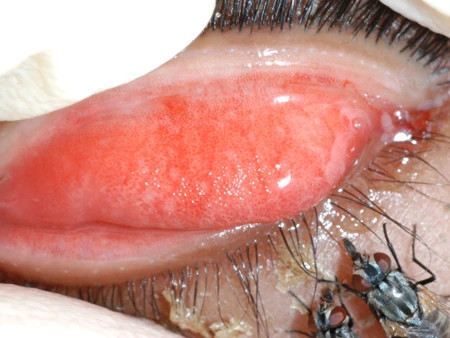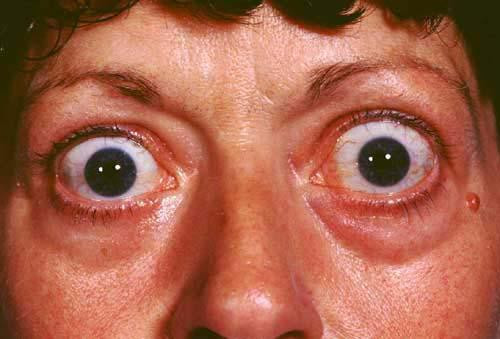Definisi
Trakoma merupakan infeksi bakteri Chlamydia trachomatis pada mata. Trakoma bersifat menular, menyebar melalui kontak dengan mata, kelopak mata, cairan hidung, atau tenggorokan orang yang terinfeksi. Infeksi ini juga dapat ditularkan melalui barang-barang yang terinfeksi, seperti sapu tangan.
Gejala awal trakoma dapat berupa gatal ringan serta iritasi pada mata dan kelopak mata. Kemudian kelopak mata bisa bengkak dan bernanah. Trakoma yang tidak diobati dapat menyebabkan kebutaan.
Trakoma adalah penyebab utama kebutaan yang dapat dicegah di seluruh dunia. Sebagian besar kasus trakoma terjadi di daerah miskin Afrika, yaitu sekitar 85%. Di daerah yang banyak ditemukan trakoma, kejadian infeksi pada anak-anak di bawah 5 tahun bisa mencapai lebih dari 60%. Penanganan dini pada trakoma dapat mencegah komplikasi.
Penyebab
Trakoma disebabkan oleh bakteri Chlamydia trachomatis, yaitu bakteri yang juga menyebabkan infeksi menular seksual klamidia. Trakoma menyebar melalui kontak dengan cairan dari mata atau hidung orang yang terinfeksi. Tangan, pakaian, handuk, dan serangga bisa menjadi jalur penularan. Di negara berkembang, lalat Musca sorbens menjadi sarana penularan trakoma.
Faktor Risiko
Faktor-faktor yang meningkatkan risiko tertular trakoma meliputi:
- Tempat tinggal yang padat penduduk. Orang yang tinggal di lingkungan yang padat penduduk lebih berisiko tertular atau menyebarkan infeksi trakoma
- Kebersihan yang buruk. Kondisi kebersihan yang buruk, akses air yang tidak memadai, dan kurangnya kebersihan badan, seperti wajah atau tangan yang tidak bersih, membantu penyebaran infeksi
- Usia 4-6 tahun. Di daerah yang banyak ditemukan trakoma, infeksi ini paling sering terjadi pada anak usia 4-6 tahun
- Jenis kelamin perempuan. Di beberapa daerah, perempuan lebih berisiko tertular trakoma 2-6 kali lebih tinggi dibandingkan laki-laki. Hal ini mungkin disebabkan karena perempuan lebih banyak kontak dengan anak-anak, yang merupakan penular utama trakoma.
- Lalat Musca sorbens. Orang yang tinggal di daerah yang banyak lalat lebih rentan terhadap infeksi.
Gejala
Tanda dan gejala trakoma umumnya mempengaruhi kedua mata. Tanda dan gejala trakoma, antara lain:
- Gatal ringan serta iritasi pada mata dan kelopak mata
- Keluarnya lendir dan/atau nanah dari mata
- Pembengkakan kelopak mata
- Mata lebih sensitif terhadap cahaya (fotofobia)
- Rasa nyeri pada mata
- Mata merah
- Gangguan hingga kehilangan penglihatan
Anak kecil sangat rentan terhadap infeksi. Namun, trakoma termasuk infeksi yang berkembang perlahan dan gejala yang berat mungkin saja tidak muncul hingga anak menginjak dewasa.
Terdapat 5 fase dalam perkembangan penyakit trakoma, yaitu:
- Peradangan folikel. Fase ini merupakan tahap awal trakoma yang ditandai dengan kemunculan folikel di mata. Folikel merupakan benjolan kecil yang mengandung sel darah putih yang terletak di bagian dalam kelopak mata atas
- Peradangan berat. Pada tahap ini, infeksi mata sangat menular. Mata sedang mengalami iritasi yang berat dengan penebalan atau pembengkakan kelopak mata atas
- Jaringan parut di kelopak mata. Infeksi berulang menyebabkan bekas luka atau jaringan parut pada kelopak mata bagian dalam. Bekas luka muncul sebagai garis putih saat diperiksa dengan alat pembesar. Pada fase ini, bentuk kelopak mata menjadi terbalik ke dalam (entropion) akibat terbentuknya jaringan parut di kelopak mata
- Trikiasis. Trikiasis adalah kondisi bulu mata tumbuh terbalik ke arah bola mata. Lapisan dalam kelopak mata yang memiliki bekas luka akan berubah bentuk sehingga menyebabkan bulu mata melengkung ke dalam dan menggores selaput bening atau kornea mata.
- Kekeruhan kornea. Kornea dapat terpengaruh oleh peradangan kelopak mata. Peradangan terus menerus yang diperparah dengan goresan bulu mata pada kornes dapat menyebabkan kekeruhan kornea
Tanda dan gejala trakoma yang berat lebih sering terjadi pada kelopak mata atas dibandingkan kelopak bawah. Tanpa pengobatan yang tepat, infeksi yang dimulai pada masa kanak-kanak dapat terus berlanjut hingga dewasa.
Diagnosis
Dokter mendiagnosis trakoma melalui gejala dan riwayat kesehatan pasien, pemeriksaan fisik, serta pemeriksaan penunjang. Pemeriksaan penunjang yang dapat dilakukan adalah mengirimkan sampel cairan mata ke laboratorium untuk diperiksa apakah terdapat bakteri. Namun, tes laboratorium tidak selalu tersedia di tempat-tempat yang banyak ditemukan kasus trakoma.
Tata Laksana
Pilihan pengobatan dan terapi trakoma bergantung pada stadium penyakitnya.
Pengobatan
Pada tahap awal, pengobatan antibiotik saja dapat menyembuhkan infeksi. Dokter dapat meresepkan salep mata tetrasiklin atau azitromisin oral (tablet). Azitromisin cenderung lebih efektif dibanding tetrasiklin, namun harganya lebih mahal.
WHO merekomendasikan pemberian antibiotik kepada seluruh komunitas ketika lebih dari 10% anak-anak telah terkena trakoma. Tujuan dari rekomendasi ini adalah untuk mengobati siapa saja yang terpapar trakoma dan mengurangi penyebaran trakoma.
Pembedahan
Pengobatan trakoma stadium lanjut, termasuk kelainan bentuk kelopak mata, mungkin memerlukan pembedahan. Pada operasi perbaikan bentuk kelopak mata, dokter membuat sayatan pada jaringan parut kelopak mata dan memutar bulu mata keluar menjauhi kornea. Prosedur ini bertujuan membatasi perkembangan jaringan parut kornea dan membantu mencegah hilangnya penglihatan lebih lanjut.
Jika kornea cukup keruh sehingga mengganggu penglihatan, transplantasi kornea dapat menjadi pilihan. Pada beberapa kasus, Anda dapat menghilangkan bulu mata dengan cara mencukurnya. Langkah ini mungkin perlu dilakukan berulang agar bulu mata tidak menggores selaput mata.
Komplikasi
Infeksi trakoma yang terjadi satu kali lebih mudah diobati dengan deteksi dini dan penggunaan antibiotik. Infeksi yang berulang dapat menyebabkan komplikasi, seperti:
- Jaringan parut pada kelopak mata bagian dalam
- Kelainan bentuk kelopak mata, seperti kelopak mata terlipat ke dalam (entropion) atau bulu mata tumbuh ke dalam (trichiasis). Kedua kondisi ini dapat menggores kornea
- Kekeruhan kornea
- Kehilangan penglihatan sebagian atau seluruhnya
Pencegahan
Jika Anda telah mendapat pengobatan antibiotik atau pembedahan, infeksi ulang masih dapat terjadi. Untuk mencegah Anda dan orang lain terinfeksi, pastikan anggota keluarga atau orang lain yang tinggal bersama Anda diperiksa dan diobati jika mengalami infeksi trakoma.
Trakoma dapat terjadi di seluruh dunia, namun lebih sering ditemukan di Afrika, Asia, Amerika Latin, Timur Tengah, dan Lingkar Pasifik. Ketika berada di daerah yang banyak ditemukan trakoma, Anda harus menjaga kebersihan agar terhindar dari infeksi trakoma. Praktik kebersihan yang baik meliputi:
- Mencuci muka dan tangan. Menjaga wajah dan tangan tetap bersih dapat membantu memutus siklus infeksi berulang
- Mengontrol populasi lalat. Dengan mengurangi populasi lalat, akan membantu menghilangkan sumber penularan infeksi
- Mengelola sampah dengan benar. Membuang kotoran hewan atau manusia dengan benar dapat mengurangi tempat perkembangbiakan lalat
- Meningkatkan akses air bersih untuk membantu meningkatkan kebersihan
Belum ada vaksin trakoma yang tersedia, namun pencegahan lainnya dapat dilakukan. WHO telah mengembangkan strategi untuk mencegah trakoma dengan tujuan menghilangkannya pada tahun 2020. Meskipun tujuan tersebut belum sepenuhnya tercapai, namun kasus trakoma telah menurun tajam. Strategi tersebut bertajuk SAFE, yaitu:
- Surgery atau pembedahan untuk mengobati trakoma tahap lanjut
- Antibiotik untuk mengobati dan mencegah infeksi
- Facial cleanliness atau menjaga kebersihan wajah
- Environmental improvements atau perbaikan lingkungan, khususnya sanitasi air dan pengendalian lalat
Trakoma adalah infeksi menular. Dengan mengobatinya sesegera mungkin, dapat membantu mencegah infeksi yang serius.
Kapan Harus ke Dokter?
Konsultasi ke dokter jika Anda atau anak Anda mengalami gejala mata gatal, iritasi, atau keluar cairan dari mata, terutama jika Anda tinggal atau baru saja bepergian ke daerah yang banyak ditemukan infeksi trakoma.
Mau tahu informasi seputar penyakit lainnya? Cek di sini, ya!
- dr Anita Larasati Priyono
Trachoma. (2020). Retrieved 3 April 2022, from https://www.mayoclinic.org/diseases-conditions/trachoma/symptoms-causes/syc-20378505
Lee AG. (2019). Trachoma. Retrieved 3 April 2022, from https://emedicine.medscape.com/article/1202088-overview
Trachoma. (2022). Retrieved 3 April 2022, from https://www.who.int/news-room/fact-sheets/detail/trachoma
Frothingham S. (2019). Can you get Chlamydia in your eye?. Retrieved 3 April 2022, from https://www.healthline.com/health/chlamydia-in-eye
Trachoma. (2021). Retrieved 3 April 2022, from https://www.cdc.gov/healthywater/hygiene/disease/trachoma.html
Turbert D. (2022). What is trachoma?. Retrieved 3 April 2022, from https://www.aao.org/eye-health/diseases/what-is-trachoma










